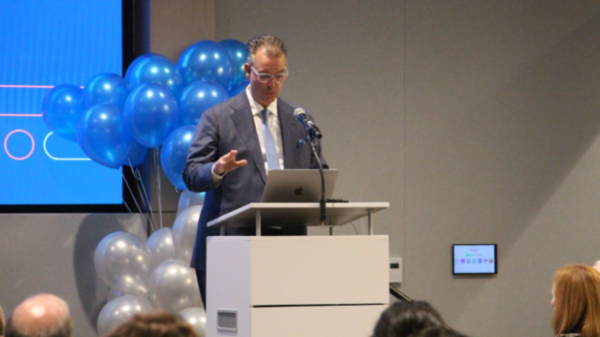By Talia Richman

Every three weeks, Irving schools send parents a progress report. But it’s no longer just an alert about grades.
Also included is how many days their children missed classes. If a student hits several absences, a personalized card encourages parents to ensure the trend doesn’t continue.
The district’s pitch to families is simple: None of the learning experiences you want for your children can happen if they’re not in class.
Higher rates of chronic absenteeism are one of the sticky repercussions of the COVID-19 pandemic. Officials in districts such as Irving ISD know they must take creative — sometimes intensive — steps to rein in the high-stakes problem.
“We have to partner with parents,” said Reny Lizardo, the campus operations director. “This is definitely an ‘it’s gonna take both of us’ situation.”
One in five Texas students was considered chronically absent in the 2022-23 school year, according to data collected by The Associated Press and Stanford University economist Thomas Dee as part of a national analysis.

Chronically absent students are at higher risk of illiteracy and eventually dropping out, research shows. These children also miss the meals, counseling and socialization provided at school. Meanwhile, Texas schools lose money as state funding is based on how many kids show up to class.
Years after the pandemic upended American schooling, nearly every state still struggles with attendance.
Roughly one in four students in the 2022-23 school year remained chronically absent, meaning they missed at least 10% of the school year. That represents about 12 million children in the 42 states and Washington, D.C., where data is available.
Only 15% of students missed that much school before the pandemic.
Society may have largely moved on from COVID, but school leaders say they still battle the effects of school closures. After as much as a year at home, many kids felt overwhelmed, bored or stressed in class. More than ever, students and parents are deciding it’s OK to stay home, which makes catching up even harder.
“There’s a shift in the mindset about school,” said Angela Daniels, Garland schools’ student engagement administrator. “Parents have also adjusted their mindset in that, if you’re having a mental health day, or you don’t feel well, or you don’t want to go to school today, it’s OK.”
In all but one state, Arkansas, absence rates remain higher than they were pre-pandemic. However, the researchers’ analysis pointed to promising data: Almost every state saw absenteeism improve at least slightly from 2021-22 to 2022-23.

In Texas, the rate dropped from over 25% to roughly 20% — one of the biggest improvements in the nationwide analysis. Prior to the pandemic, the state’s chronic absenteeism rate was 11%.
Educators say they are working to identify students with slipping attendance, then providing help. And key to that is closing communication gaps with parents, who often aren’t aware their child is missing so much school or why it’s problematic.
So far, the solutions that appear to help are simple — such as postcards to parents that compare a child’s attendance with peers. But to make more progress, schools must get creative to address their students’ needs, experts say.
Many of the reasons kids missed class early in the pandemic are still firmly in place: financial hardship, transportation problems, mild illness and mental health struggles.
Schools’ solutions
Irving schools staff used to attempt to make hundreds of phone calls a day to reach the families of students who didn’t show up.
“There were so many absent students. We just never got ahead of it,” Lizardo said. “You’re constantly behind, because even if an attendance clerk works at rapid speed, they’re not going to make all 100 phone calls in a day.”
So last year, the district partnered with an education technology company to use its suite of attendance tools. Parents now automatically get a text — written in the language they speak at home — when their children miss school.
Parents can respond in their native language, too. The platform translates their answers so nonbilingual teachers can chat with them.
Such a tool is helpful in a diverse district such as Irving, where families speak Spanish, Urdu and dozens of other languages at home.
The conversations typically reveal a concrete reason behind why a child’s not coming to school, Lizardo said. School staff then zero in: Is there something we can do to fix it?
For families experiencing homelessness, for example, a lack of transportation can get in the way. Lizardo’s team will jump in to offer students DART passes. They’ll connect them with a student-friendly rideshare program.
“Those are all services we can offer to them — if we just know, if we’re able to make that connection,” he said.
In Garland, the district used its federal pandemic relief funding to bolster a team of seven retention specialists who made home visits to students who were frequently absent.
“Sometimes, it would take us two or three times, talking to a family, really sitting down for an hour with families,” Daniels said. The reasons why kids didn’t show up to class were layered, “and you really have to spend time with those families to work through all of those issues.”
But the funding that supported the positions is expiring. This school year, the team is down to two retention specialists. Their work now, Daniels said, will be “less individualized.”
Texas policies
Texas is among only a handful of states that use average daily attendance — rather than other enrollment measures — to calculate state funding for public schools.
That means chronic absenteeism doesn’t just hurt the kids who aren’t coming to class. If fewer students show up, districts end up receiving less money for boosting all children’s learning.
Dallas schools Superintendent Stephanie Elizalde has called this practice “one of the most inequitable practices that the state could have with public school funding.”
Students who struggle to attend school regularly are often those who face the biggest challenges in their communities, she said. Roughly 85% of Dallas ISD students are considered economically disadvantaged.
“They have the least amount of access to healthy food. They have the least amount of access to transportation,” Elizalde explained during a budget briefing this year. “Many times our children have stayed home to help take care of a sick sibling or they have to take care of their parents.”
Dallas schools had a nearly 28% chronic absenteeism rate in 2021-22, the latest available district-level data reported to the state. Roughly a quarter of Garland students were chronically absent that year. In Irving, it was closer to one in three.
Lawmakers tried and failed in previous legislative sessions to change the funding formula to enrollment rather than attendance.
The Legislature has also changed the state’s approach to truancy, moving to decriminalize it.
Before the state’s sweeping changes in 2015, Texas children and teenagers who missed too much school could face steep fines and, in some cases, jail time.
Education advocates pointed to the system as an example of perpetuating the criminalization of vulnerable students.
Under the reformed system, districts must provide truancy prevention measures to limit the need for court referrals. After a student misses a certain number of days, school officials must send a letter to the parent scheduling a meeting. Then they must develop a plan of action, which can include sending the student to counseling, community service or mentoring.
If a student continues missing school regularly, the child or the parents still can be referred to truancy court, where a judge may assess fines.
Some leaders have complained that this approach lacks teeth, an argument that bubbled up to lawmakers. Garland ISD’s Daniels said she expects the district to file more truancy cases this year.
“We do need to have some sort of accountability,” she said. “We want to get them before the judge a little sooner, instead of the ‘wait and see.’ ”
Data for this article was collected by Professor Thomas Dee of Stanford University and data journalist Sharon Lurye of the Associated Press. Reporters Jocelyn Gecker and Bianca Vázquez Toness, also of the AP, contributed to this report.
The DMN Education Lab deepens the coverage and conversation about urgent education issues critical to the future of North Texas.
The DMN Education Lab is a community-funded journalism initiative, with support from Bobby and Lottye Lyle, Communities Foundation of Texas, The Dallas Foundation, Dallas Regional Chamber, Deedie Rose, Garrett and Cecilia Boone, The Meadows Foundation, The Murrell Foundation, Solutions Journalism Network, Southern Methodist University, Sydney Smith Hicks and the University of Texas at Dallas. The Dallas Morning News retains full editorial control of the Education Lab’s journalism.









You must be logged in to post a comment Login